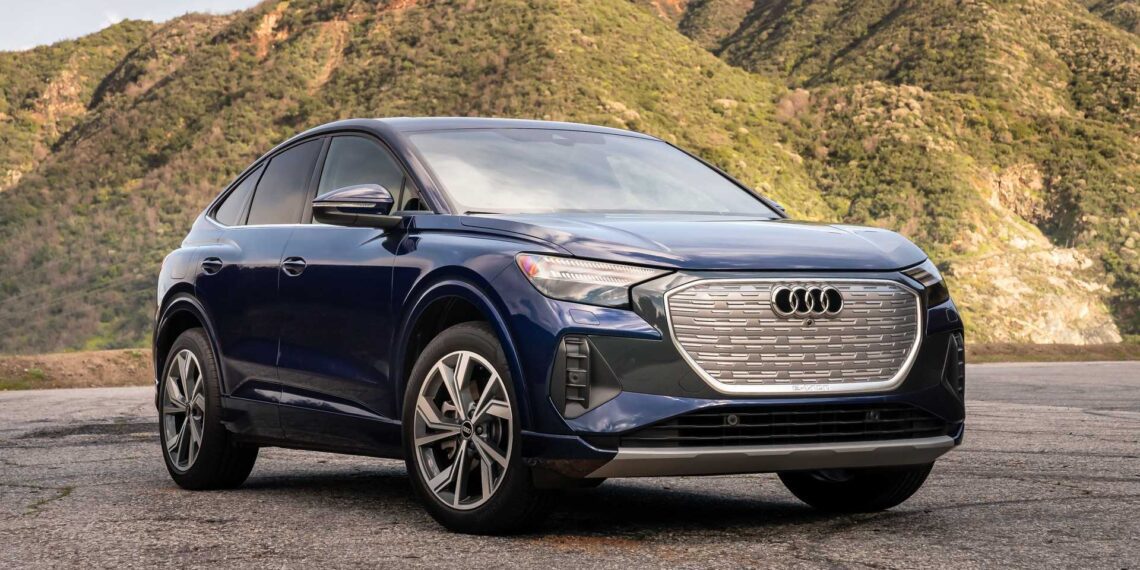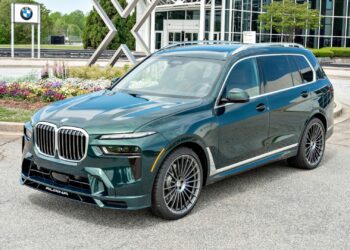Platform sharing across automakers is nothing new, but no one does it better than the Volkswagen Group. How the Lamborghini Urus and Audi A4 share a modular platform but still manage to be excellent products within their respective categories is a testament to the group’s clever engineers. The latest vehicle to employ this tactic is the 2022 Audi Q4 Sportback e-tron, based on the Volkswagen ID.4.
However, we’re not just talking about a platform in this case. This Audi shares its battery pack, electric motors, suspension, brakes, and more with its Volkswagen sibling. It’s only visually where the Audi brakes away from the ID.4 with its sleek styling and ergonomic interior with a healthy helping of buttons and switches. But are good looks and a comfortable ride enough to compete in a growing premium segment?

Quick Specs
| Motor | Asynchronous (Front) / Permanent-Magnet Synchronous (Rear) |
| Output | 295 Horsepower / 339 Pound Feet |
| 0-60 MPH | 5.8 Seconds |
| Base Price | $53,795 |
| As-Tested Price | $60,690 |
A Familiar Face
Audi’s current corporate design language is excellent. From its flagship e-tron GT to this “entry-level” electrified Q4, the German carmaker’s EVs don’t rely on aero-focused and futuristic styling to differentiate themselves. Instead, subtle changes signify this car’s lack of an ICE, like its closed-off silver grille up front and e-tron script displayed on its rear bumper. Otherwise, it looks similar to the gas-powered Q3s and Q4s, like a stylish and compact city runaround.
While this styling decision doesn’t make the Q4 e-tron stand out as a revolutionary product, it blends seamlessly into the carmaker’s product line. It’ll also make it easier for current Audi owners to transition into an EV without giving up the exterior styling or interior layout they’re used to.

It’s only its silhouette that reveals its ID.4 roots. Despite being a small crossover, it’s tall with an upright hood and shoulder line, and in the case of this Sportback variant, a sloping roofline. While this styling element has found success in larger models like the Q8, Im not convinced it works as well in such a small platform with so little room to slope down and create a coupe-style aesthetic. Since it results in a smaller rear window sandwiched between its rear spoiler and prominent LED light bar, I suspect the standard Q4 e-tron is still the one to have.
Unlike the ID.4, however, the Q4 e-tron is immediately identifiable as a premium product. Despite its relatively small footprint, its sporty bumpers and sleek lighting elements help distance it from its Volkswagen sibling. Its large grille and wide rear light bar help visually widen it, giving Audi’s smallest EV a fair amount of road presence. My Sportback tester comes standard with a set of 20-inch wheels, which ties its exterior together nicely while contrasting its dark Navarra Blue paint.

City Street Crawler
The Audi Q4 e-tron is available with two powertrains, a single motor base variant with 201 hp and 229 lb-ft of torque, and a dual motor setup with 295 hp and 339 lb-ft. The Sportback I’ve been living with is only available with the latter. Both of these configurations, along with its 77 kWh battery back, are carryovers from the ID.4. In this range-topping configuration, the e-tron is capable of up to 241 miles of range.
The base 40 model sprints to 60 mph in 7.9 seconds, while a pricier 50 model, like my tester, gets there in 5.8 seconds. Given its instant torque delivery, the Sportback feels even quicker on the road than its 0-60 time suggests. Despite counting on a single-speed transmission, the small e-tron is quick even when you’re already at speed, making it responsive in almost any scenario.
Brisk acceleration aside, this electric crossover is destined for city streets and highway commutes. Its suspension is soft, and with plenty of sidewall from its tires, it soaks up bumps well. Combined with its small footprint, the Sportback is ideally suited for a major city like Los Angeles. Road and wind noise remains relatively low, making this e-tron an effortless and cozy commuter.

Of course, I couldn’t resist a canyon run to see what it’s like at speed, and it’s understandably far from sporty. Its daily-driver-friendly suspension means it rolls in the corners, and its range-friendly tires also make it understeer easily. Not that this matters much to most Q4 e-tron buyers, but its brakes certainly will.
Unlike some competitors, the Q4 Sportback e-tron doesn’t offer one-pedal driving capabilities. While there’s regenerative braking onboard, it’s not powerful enough to rely solely on. Even in its most aggressive setting, a press of the brake pedal is required to come to a complete stop in most scenarios. There’s plenty of travel between when your foot meets the pedal and when the brakes respond. Extracting proper braking performance also requires a fair bit of force.
Like most Audis, the Sportback’s steering is light and offers little feedback. You’ll hear the tires braking traction before you’ll feel it. On the flip side, its lightness makes maneuvering this small crossover around town a breeze. This electrified crossover is not for those looking for a sporty daily, but more so for those after an effortless and comfortable commuter.

Better With Buttons
Inside, the Audi Q4 e-tron partially fixes my greatest gripe with the ID.4, its haptic feedback controls. While the Sportback’s cabin still has few traditional buttons, all its HCAV controls count on physical switches. The only one missing is its volume controller, which relies on a touch-sensitive dial in the center console.
I say partially fixed because its steering wheel still relies on haptic buttons. They’re great to look at but far from accurate, often requiring a few presses to respond correctly. Late last year, Volkswagen CEO Thomas Schäfer announced that physical steering wheel buttons would return, so let’s hope they trickle up to Audi.
The rest of the interior is excellently laid out, less futuristic and cutting edge, and more like the rest of Audi’s e-tron range. In front of the driver sits a 10.25-in digital instrument cluster complemented by a second 10.1-in screen in its dashboard. Anyone familiar with the carmaker’s virtual cockpit will recognize its graphics and format. There may not be any flashy colors or animations to give its driver a sense of speed, but it’s easy to read and shows you a fair amount of information without being distracting.

Its second display houses Audi’s latest MMI system, which also finds its way into the pricier e-trons at the top of the brand’s model range. While the carmaker’s native system is easy to use, wireless Apple CarPlay and Android Auto come standard.
Regarding cargo space, the Q4 Sportback e-tron offers 26.1 cu ft with the seats up and 54.4 cu ft with them down. This is Q4 about on par with the Volvo XC40 Recharge and Genesis GV60, and only behind the Mercedes-Benz EQB and its 62 cu ft of space with its seats folded. Despite its relatively small footprint, it’ll comfortably seat five with plenty of headroom and ample space.
While its eight-way adjustable front seats look relatively flat and uninviting at first glance, they’re surprisingly comfortable for longer drives thanks to four-way lumbar adjustability. Upgraded chairs are available for $950 and offer better side bolsters and a more appealing design, so I’d suggest splurging for them.

While the Q4 e-tron’s cabin is comfortable and quiet, its materials feel far more Volkswagen than Audi. There are plenty of hard plastics; few touch surfaces feel like what you expect in a premium product. Even its faux-leather seats feel somewhat thin, which is disappointing considering how great the higher-priced e-tron’s look and feel. As you’ll find out later, this Sportback’s latest iteration still carries a premium price tag.
Charging/Range
The Q4 Sportback e-tron offers up to 241 miles of range from its 77 kWh net (82 kWh gross) battery pack. Its 400-volt electric architecture caps its DC fast charging rate at 150 kW. This is on par with the Mercedes-Benz EQB and Volvo XC40 Recharge but behind the Genesis GV60’s 800-volt architecture and peak charge rate of 235 kW. Regardless of trim level, all e-trons come standard with two years of free charging at Electrify America stations.
Pricing
As you may have noticed by the title, I’ve been running around in a 2022 model-year e-tron with a $53,795 base price, including a $1,095 destination fee. Its only two options are its $595 Navarra Blue paint and the $6,300 Prestige package. Its as-tested price is $60,690.
However, for the 2023 model year, prices have increased. The Sportback variant now costs $59,395, including a $1,195 destination fee. A similarly optioned Sportback now costs a whopping $67,690, marking a $7,000 increase from one model year to the next.
At this updated price point, the coupe-styled Q4 sits alongside the most expensive variants of the Volvo XC40 Recharge, Mercedes-Benz EQB, and Tesa Model Y. If extracting the best value out of Q4 e-tron is the goal, stick to the standard model and its single motor, $50,995, and dual-motor, $56,395 base prices.

Closing Thoughts
As a machine to commute across a crowded city like Los Angeles, the Audi Q4 Sportback e-tron is hard to fault. It’s comfortable, spacious, stylish, and quick. It’s no segment leader but offers almost everything you’d want from a daily driver. Don’t, however, expect it to be an exciting or engaging drive. With its light steering, soft suspension, and lackluster braking performance, this is a city crawler through and through.
Which I suspect is fine for most people shopping in this category. What the Q4 excels at is looking like an Audi, meaning buyers used to the brand’s interior layout and exterior styling will have an easier time transitioning from an ICE Q3, Q4, or Q5 into the e-tron. On the flip side, it may be harder to convert first-time Audi buyers, given the Sportback’s high price tag and strong competition from Volvo, Mercedes-Benz, and Tesla.
So while it may share a platform and driving experience with a Volkswagen ID.4, everything you see and interact with feels distinctly Audi. For most buyers, the price delta between the two won’t come down to range and performance. For most people, its appeal will lie in its looks, sleek interior, and, most importantly, its badge.





























